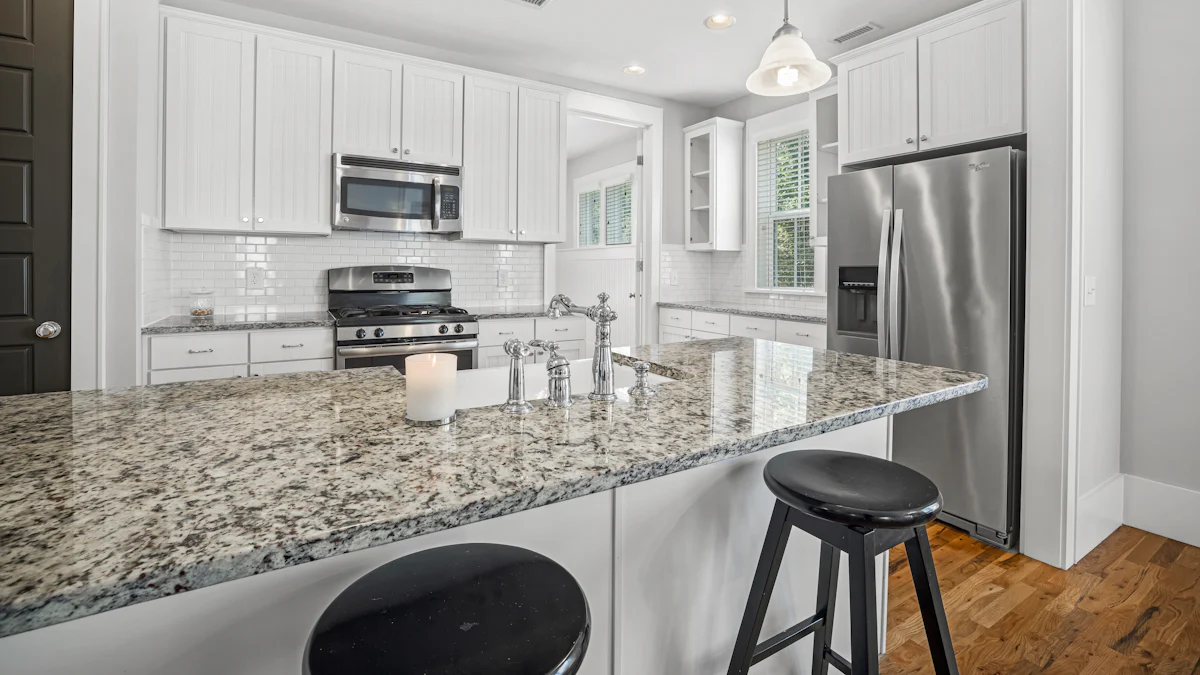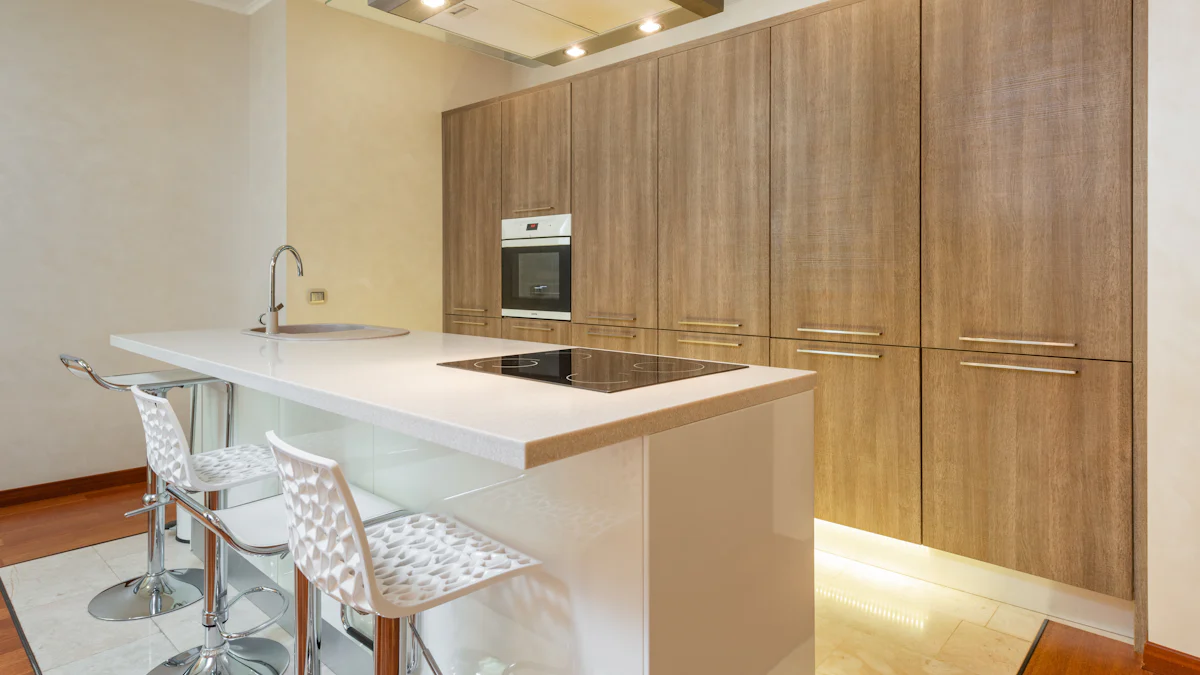Advancements in Induction Cooktops with Built-in Downdrafts

Induction cooktop downdraft systems represent a significant leap in kitchen technology. You will find that these modern appliances combine the efficiency of induction cooking with the practicality of integrated ventilation. This innovation eliminates the need for bulky overhead hoods, offering a sleek and unobtrusive design. In North America, the adoption of induction cooktop downdraft technology has surged by approximately 62% since 2018, highlighting its growing popularity. Residential induction cooktops now provide a cleaner, more efficient cooking experience, making them a preferred choice for contemporary kitchens.
Key Takeaways
Induction cooktop downdraft systems combine efficient cooking with integrated ventilation, eliminating the need for bulky overhead hoods.
These cooktops enhance kitchen aesthetics with a sleek, minimalist design that seamlessly integrates into modern kitchens.
Induction technology offers precise temperature control and energy efficiency, making cooking faster and more sustainable.
The advanced downdraft ventilation captures smoke and odors directly from the cooking surface, ensuring a cleaner kitchen environment.
Downdraft induction hobs operate quietly, providing a peaceful cooking experience compared to traditional extractor hoods.
Choosing the right materials and finishes for your downdraft cooktop can enhance both functionality and the overall look of your kitchen.
Professional installation is recommended to ensure optimal performance and efficiency of the downdraft ventilation system.
Design Features of Induction Cooktop Downdraft

Integration of Downdraft Ventilation
When you explore the world of downdraft induction hobs, you'll notice a remarkable feature: the integration of a downdraft ventilation system. This system is ingeniously built into the surface of the cooktop, eliminating the need for traditional overhead hoods. The integrated ventilation system draws air directly from the cooking surface, efficiently removing smoke and odors. This setup not only enhances the cooking experience but also maintains a clean kitchen environment. You can find this technology in various configurations, including gas, electric, and induction, offering flexibility to suit your cooking preferences.
Impact on Kitchen Aesthetics
The induction cooktop downdraft design significantly impacts kitchen aesthetics. By removing the need for bulky overhead vents, these cooktops create a sleek and modern look. The new generation downdraft vents blend seamlessly with the kitchen's design, providing a minimalist appearance. This integration allows you to focus on the beauty of your kitchen without compromising on functionality. The unobtrusive design of downdraft induction hobs makes them an ideal choice for contemporary kitchens, where style and efficiency go hand in hand.
Material and Finish Options
You have a variety of material and finish options when selecting a downdraft induction hob. Manufacturers offer these cooktops in stainless steel, glass, and ceramic finishes, allowing you to match your kitchen's decor. Each material provides durability and easy cleaning, ensuring that your cooktop remains in pristine condition. The choice of finish can enhance the overall look of your kitchen, making it both functional and visually appealing. Whether you prefer a classic stainless steel look or a modern glass finish, there's an option to suit your style.
Performance Metrics of Downdraft Induction Hobs
Extraction Capabilities
When you consider the performance of downdraft induction hobs, their extraction capabilities stand out. These hobs excel at capturing smoke and odors directly from the cooking surface. This efficiency results from the advanced downdraft ventilation system integrated into the cooktop. Unlike traditional extractor hoods, which pull air from above, downdraft systems draw air downward, ensuring that smoke and odors are captured at the source. This method not only keeps your kitchen air clean but also enhances the overall cooking experience by minimizing lingering smells.
Noise Levels
Noise levels play a crucial role in the usability of any kitchen appliance. Downdraft induction hobs have made significant strides in reducing noise compared to their predecessors. At their highest setting, these hobs produce noise levels comparable to a normal conversation or light traffic. This improvement makes them much quieter than traditional extractor hoods, which can be quite loud. The advancements in technology have led to quieter operation, allowing you to enjoy a peaceful cooking environment without the disruptive noise often associated with older models.
User Experience with Induction Cooktop
Ease of Use and Control Features
When you use an induction cooktop, you will notice its intuitive design. The controls are often touch-sensitive, allowing you to adjust the heat with precision. This feature makes induction cooking both efficient and user-friendly. You can quickly change the temperature, which is crucial for recipes requiring precise heat control. The induction technology ensures that the cooktop heats only the cookware, keeping the surrounding surface cool and safe to touch. This safety feature is particularly beneficial in homes with children.
The integrated ventilation system in these cooktops further enhances usability. By eliminating the need for separate ventilation units, you gain more counter space and a cleaner kitchen environment. The downdraft ventilation system effectively removes smoke and odors, ensuring a pleasant cooking experience. You can focus on your culinary creations without worrying about lingering smells or smoke.
Comparison with Traditional Systems
Comparing induction cooktops with traditional systems reveals several advantages. Traditional gas and electric cooktops often require more time to heat up and cool down. In contrast, induction cooktops provide immediate heat, reducing cooking times significantly. This efficiency not only saves time but also conserves energy, making induction a more sustainable choice.
Traditional systems usually rely on overhead hoods for ventilation, which can be bulky and noisy. The induction cooktop downdraft system offers a quieter and more streamlined alternative. It integrates seamlessly into the cooktop, maintaining the kitchen's aesthetic appeal. You will appreciate the unobtrusive design that complements modern kitchen layouts.
Moreover, the induction cooktop offers a safer cooking environment. Unlike traditional systems, the cooktop surface remains cool, reducing the risk of burns. This feature, combined with the advanced induction technology, provides a superior cooking experience. You can enjoy the benefits of fast, efficient, and safe cooking with an induction cooktop.
Installation Considerations for Induction Cooktop Downdraft

When you decide to install an induction cooktop with downdraft ventilation, understanding the installation requirements is crucial. Proper installation ensures that your cooktop operates efficiently and lasts longer. Here are some key considerations to keep in mind:
Ducting Requirements
Professional Installation: You should always opt for professional installation. Experts follow manufacturer guidelines precisely, which is essential for optimal performance. They ensure that the downdraft ventilation system is correctly integrated into your kitchen setup.
Ducting Path: Plan the ducting path carefully. The ducting should be as short and straight as possible to maximize the efficiency of the ventilation system. Avoid sharp bends and long runs, as these can reduce airflow and affect performance.
Ventilation Flow: Regular maintenance of the ventilation system is vital. Clean the ducts periodically to prevent blockages and ensure proper airflow. This maintenance helps preserve the efficiency of your induction cooktop.
Space Considerations: Ensure that there is enough space beneath the cooktop for the ducting. The space should accommodate the ductwork without compromising the structural integrity of your kitchen cabinets.
Ideal Scenarios for Use
Open Kitchens: Induction cooktops with integrated ventilation are ideal for open kitchen designs. They eliminate the need for bulky overhead hoods, maintaining a clean and unobtrusive look.
Limited Space: If your kitchen has limited space, a 4-zone induction cooktop with downdraft ventilation can be a perfect choice. It combines cooking and ventilation in one unit, saving valuable counter space.
Modern Aesthetics: For those who prioritize modern aesthetics, these cooktops offer a sleek and minimalist design. They blend seamlessly with contemporary kitchen styles, enhancing the overall look.
Energy Efficiency: Induction stoves are known for their energy efficiency. By choosing a model with integrated ventilation, you further enhance this efficiency by ensuring that smoke and odors are effectively managed without additional energy-consuming appliances.
By considering these factors, you can ensure that your induction cooktop with downdraft ventilation is installed correctly and functions optimally, providing you with a superior cooking experience.
Market Trends and Influences in Downdraft Induction Hobs
Adoption Rates and Consumer Preferences
You might notice a significant shift in consumer preferences towards downdraft induction hobs. Since 2018, the adoption of induction technology has grown by approximately 62% in North America. This surge reflects a growing demand for efficient and modern kitchen solutions. Consumers increasingly prefer induction cooktops due to their energy efficiency and sleek design. The ability to integrate ventilation directly into the cooking surface appeals to those seeking a minimalist kitchen aesthetic.
In the Asia-Pacific region, the market for built-in induction hobs is expected to grow at the highest rate. This growth is driven by the rising trend of modular kitchens and the increasing cost of conventional gas cooktops. As more consumers prioritize energy efficiency and modernity, induction cooking becomes a more attractive option. The market for residential induction cooktops is projected to achieve a compound annual growth rate (CAGR) of 6%, highlighting the sustained interest in this technology.
Industry Partnerships and Innovations
The industry continues to innovate, with manufacturers forming strategic partnerships to enhance the capabilities of downdraft induction hobs. Collaborations between companies like Whirlpool and BORA have led to advancements in integrated ventilation systems. These partnerships focus on improving the user experience by offering precise cooking controls and efficient odor elimination.
Manufacturers offer a variety of power ratings to cater to different cooking needs. This flexibility allows you to choose a cooktop that fits your culinary style and kitchen layout. The integration of advanced technology in downdraft induction hobs ensures precise and energy-efficient cooking. This innovation not only enhances the cooking experience but also contributes to a cleaner kitchen environment.
As the market evolves, you can expect further innovations in induction technology. The combination of cooking and ventilation functions in a single unit eliminates the need for separate range hoods. This feature is available across gas, electric, and induction cooktops, providing versatility and convenience for modern kitchens.
The advancements in induction cooktop downdraft systems offer numerous benefits. You gain a cleaner, more efficient cooking experience with integrated ventilation, eliminating the need for bulky overhead hoods. Induction cooking provides precise temperature control and energy efficiency, making it a preferred choice for modern kitchens. As technology evolves, you can expect further integration of smart features, enhancing both functionality and aesthetics. The market for induction cooktops continues to grow, driven by consumer demand for energy-efficient and space-saving solutions. This trend will shape future kitchen designs, emphasizing sustainability and innovation.
FAQ
What is a Downdraft Cooktop?
A downdraft cooktop combines cooking and ventilation in one unit. It integrates vents along the edges or in the center of the cooking surface. This design eliminates the need for a range hood. You can find downdraft technology in gas, electric, and induction cooktops.
What are some features of downdraft cooktops?
Downdraft cooktops offer more than just powerful ventilation. They include various burner sizes and intuitive touch controls. Safety features like automatic shut-off enhance your cooking experience. Some models even come with specialized attachments like grill or griddle modules for versatile cooking options.
How does a downdraft cooktop improve kitchen aesthetics?
Downdraft cooktops eliminate bulky overhead hoods. This creates a sleek and modern kitchen look. The unobtrusive design blends seamlessly with contemporary kitchen styles. You can enjoy a minimalist aesthetic without sacrificing functionality.
Are downdraft cooktops energy efficient?
Yes, downdraft cooktops are energy efficient. Induction models, in particular, heat cookware directly. This results in faster cooking times and reduced energy consumption. You can enjoy both efficient cooking and effective ventilation.
How do downdraft cooktops handle smoke and odors?
Downdraft cooktops capture smoke and odors directly from the cooking surface. The integrated ventilation system draws air downward. This method ensures that smoke and odors are captured at the source. Your kitchen air remains clean and fresh.
Can I install a downdraft cooktop in any kitchen?
You can install a downdraft cooktop in most kitchens. However, consider the ducting requirements. Ensure there is enough space beneath the cooktop for ductwork. Professional installation is recommended for optimal performance.
What are the noise levels like for downdraft cooktops?
Downdraft cooktops operate quietly. At their highest setting, they produce noise levels similar to a normal conversation. This makes them quieter than traditional extractor hoods. You can enjoy a peaceful cooking environment.
Do downdraft cooktops offer precise temperature control?
Yes, downdraft cooktops, especially induction models, offer precise temperature control. You can adjust the heat with precision using touch-sensitive controls. This feature is crucial for recipes requiring exact heat settings.
Are there different material and finish options for downdraft cooktops?
Downdraft cooktops come in various materials and finishes. You can choose from stainless steel, glass, and ceramic finishes. Each material offers durability and easy cleaning. Select a finish that matches your kitchen decor.
What are the benefits of choosing a downdraft cooktop?
Choosing a downdraft cooktop offers several benefits. You gain a cleaner, more efficient cooking experience. The integrated ventilation eliminates the need for overhead hoods. Induction models provide precise temperature control and energy efficiency. These features make downdraft cooktops a preferred choice for modern kitchens.
See Also
Essential Insights on Induction Cooktops Featuring Downdraft
Upgrade Your Kitchen with a Single Induction Cooktop
Enhance Your Culinary Skills Using Portable Induction Cooktops

